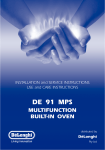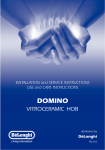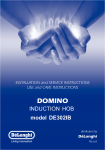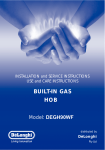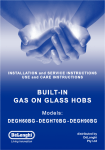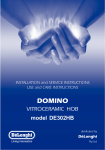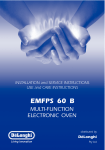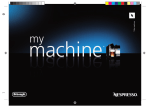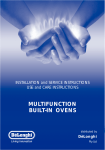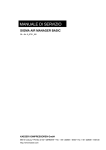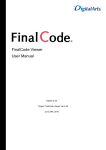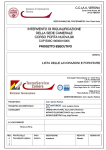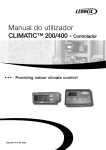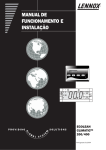Download SERVICE MANUAL
Transcript
IT EN SERVICE MANUAL Lo scopo di questo manuale è quello di fornire al personale di servizio tutte le informazioni necessarie per quanto riguarda la corretta gestione, manutenzione e riparazione della macchina per caffè Lattissima+. Questo manuale deve essere utilizzato dai tecnici come un valido aiuto per garantire un buon rendimento ed un uso corretto delle macchine. Al fine di sfruttare appieno tutte le funzioni, è assolutamente necessario seguire le istruzioni di questo manuale. Per accedere rapidamente alle informazioni direttamente da computer PC o MAC, questo manuale è disponibile come file PDF e può essere scaricato dal sito tecnico web di Nespresso sotto https: //business.nespresso.com. Le istruzioni sono parte integrante dell’apparecchio. Prima di mettere in funzione l’apparecchio, leggere tutte le istruzioni e le istruzioni per la sicurezza. I seguenti simboli indicano: Attenzione: Leggere la precauzioni indicate per evitare eventuali danni a cose o persone. Note: Leggere le indicazioni per un uso sicuro e adeguato dell’apparecchio. The purpose of this service manual is to provide the service personnel with all necessary information with regards to correct handling, maintenance and repair of the Lattissima+ coffee machine. This manual should be used by the technicians as a valuable aid to guarantee the permanent readiness for use of the machines. In order to take full advantage of all the functions, it is absolutely necessary to follow the instructions in this manual. For fast access to information directly from the PC or MAC monitor, this service manual is available as PDF file and can be downloaded from the Nespresso technical website under https://business.nespresso.com. The instructions are an integral part of the appliance. Before operating the appliance, please read all the instructions and safety notes. The following symbols indicate: Caution: Read the precautions shown to prevent any damage or harm to property or persons. N.B.: Read the instructions for safe, proper appliance use. Release 00 - 07.2011 3 Indice 1.Generalità.............................................................................. 6 1.1. 1.2. 1.3. 1.4. 1.5. Norme generali di sicurezza............................................................................... 6 Dati tecnici.................................................................................................... 8 Componenti macchina....................................................................................... 9 Circuito acqua.............................................................................................. 11 Targhette identificative................................................................................... 12 2.Utilizzo.................................................................................13 2.1. Preparazione macchina al primo utilizzo o dopo un lungo periodo di non utilizzo.......... 2.2. Preparazione Caffè........................................................................................ 2.3. Montaggio/smontaggio Sistema Rapid Cappuccino (R.C.S)......................................... 2.4. Preparazione Cappuccino e Latte Macchiato......................................................... 2.5. Programmare la quantità di acqua...................................................................... 2.6. Programmare la quantità di Cappuccino/Latte Macchiato......................................... 2.7. Risciacquo dopo ogni preparazione di ricetta a base di latte..................................... 2.8. Pulizie quotidiane.......................................................................................... 2.9. Pulizia del Sistema Rapid Cappuccino due volte a settimana..................................... 2.10.Svuotamento della macchina (prima delle operazioni di riparazione).......................... 2.11.Modalità risparmio energetico........................................................................... 2.12.Decalcificazione............................................................................................ 2.13.Impostazione durezza dell’acqua....................................................................... 2.14.Ripristinare le quantità originali........................................................................ 2.15.Funzioni statistiche........................................................................................ 2.16.Smaltimento e ambiente.................................................................................. 3. 13 15 16 17 19 20 21 22 22 23 24 25 28 29 30 30 Ricerca guasti.........................................................................31 3.1. Controllo macchina al ricevimento..................................................................... 31 3.2.Malfunzionamenti.......................................................................................... 32 4.Manutenzione........................................................................34 4.1. Controllo pressione e perdite di tenuta............................................................... 34 4.2. Misurazione temperatura caffè.......................................................................... 36 4.3. Misurazione temperatura latte.......................................................................... 37 5.Riparazione...........................................................................38 5.1. 5.2. 5.3. 5.4. 5.5. Smontaggio generale...................................................................................... Rimozione scheda pulsanti............................................................................... Rimozione infusore........................................................................................ Rimozione scheda.......................................................................................... Rimozione gruppo Generatore/Vaporizzatore/Pompa.............................................. 38 39 40 41 42 6. Test di sicurezza.....................................................................46 7. Schemi elettrici......................................................................47 8.Ricambi................................................................................49 9.Garanzia...............................................................................54 Release 00 - 07.2011 4 Contents 1.Generality.............................................................................. 6 1.1. 1.2. 1.3. 1.4. 1.5. General safety notes........................................................................................ 6 Technical data................................................................................................ 8 Main components............................................................................................ 9 Water circuit................................................................................................ 11 Identification plates...................................................................................... 12 2.Using...................................................................................13 2.1. Preparing to use the machine for the first time or after a long period of non-use......... 2.2. Coffee preparation........................................................................................ 2.3. Assembling/disassembling the Rapid Cappuccino System (R.C.S.).............................. 2.4. Preparing Cappuccino and Latte Macchiato......................................................... 2.5. Programming the amount of water.................................................................... 2.6. Programming the amount of Cappuccino/Latte Macchiato....................................... 2.7. Rinsing after preparing any milk-based recipe..................................................... 2.8. Daily cleaning............................................................................................... 2.9. Cleaning the Rapid Cappuccino System twice a week............................................. 2.10.Emptying the machine (before any repairs)......................................................... 2.11.Energy saving mode....................................................................................... 2.12.Descaling..................................................................................................... 2.13.Setting water hardness................................................................................... 2.14.Resetting the original amounts......................................................................... 2.15.Statistical mode............................................................................................ 2.16.Disposal and the environment.......................................................................... 13 15 16 17 19 20 21 22 22 23 24 25 28 29 30 30 3.Troubleshooting......................................................................31 3.1. Checking the machine upon receipt.................................................................... 31 3.2.Malfunctioning.............................................................................................. 32 4.Maintenance..........................................................................34 4.1. Checking pressure and leaks............................................................................ 34 4.2. Measuring coffee temperature.......................................................................... 36 4.3. Measuring milk temperature............................................................................ 37 5.Repair..................................................................................38 5.1. 5.2. 5.3. 5.4. 5.5. General disassembly...................................................................................... 38 Removing the button panel.............................................................................. 39 Removing the extraction unit........................................................................... 40 Removing the PCB board................................................................................. 41 Removing the Thermoblock/Steamer unit/Pump..................................................................... 42 6. Safety test............................................................................46 7. Wiring diagrams.....................................................................47 8. Spare parts...........................................................................49 9.Warranty..............................................................................54 Release 00 - 07.2011 5 Generalità Generality 1.Generalità 1.1. Norme generali di sicurezza Per evitare eventuali lesioni e danni, leggere e seguire le istruzioni interamente. Per evitare rischi di scosse elettriche letali e incendi • Collegare l’apparecchio solo ad allacciamenti di rete idonei con presa a terra. Assicurarsi che la tensione di alimentazione sia la stessa indicata sulla targhetta dell’apparecchio. L’utilizzo di collegamenti errati, rende nulla la garanzia. • Nel caso in cui occorra una prolunga, utilizzare solo un cavo a massa con una sezione del conduttore di almeno 1,5 mm2. • Non accostare il cavo a bordi taglienti. Bloccarlo o lasciarlo pendere. Tenere il cavo lontano da fonti di calore e di umidità. • Non mettere in funzione l’apparecchio se il cavo è danneggiato. • Per evitare pericolosi danni, non posizionare mai l’apparecchio sopra o accanto a superfici calde come termosifoni, fornelli elettrici o a gas, fiamme libere o simili. Appoggiarlo esclusivamente su superfici stabili e piane. La superficie d’appoggio deve essere resistente al calore e ai liquidi, come acqua, caffè, decalcificanti o simili. • Per evitare danni, scollegare l’apparecchio afferrando la spina, non tirare mai il cavo. Non toccare mai la spina con le mani umide. Per evitare eventuali danni durante il funzionamento • L’apparecchio è stato realizzato unicamente per uso domestico, in caso di uso non conforme alle istruzioni, il produttore declina qualsiasi responsabilità ed è autorizzato a non applicare i termini di garanzia. • Tenere l’apparecchio fuori dalla portata dei bambini. • Per evitare scottature, mantenere sempre chiusa la leva durante il funzionamento e non inserire le dita sotto l’ero- 1.Generality 1.1. General safety notes To prevent possible injury and damage, read and follow the instructions completely. To prevent the risk of a fatal electric shock and fire • Connect the appliance to suitable earthed mains connections only. Make sure the power supply is the same as that indicated on the rating plate. The use of incorrect connections will void the warranty. • In the event that an extension cord is required, use only one earthed cord with a conductor cross section of at least 1.5 mm2. • Do not move the cord close to sharp edges. Block it or allow it to hang. Keep the cord away from sources of heat and humidity. • Do not operate the appliance if the cord is damaged. • To prevent hazardous damage, do not place the appliance on or next to hot surfaces such as radiators, electric or gas stoves, naked flames or similar. Place it only on stable and level surfaces. The surface must be resistant to heat and liquids, such as water, coffee, descaling products or similar. • To prevent damage, unplug the appliance holding the plug. Never pull the cord. Never touch the plug with wet hands. To prevent damage during operation • The appliance has been designed for domestic use only. If it is not used in accordance with the instructions, the manufacturer assumes no responsibility and is authorised not to apply the warranty conditions. • Keep the appliance out of reach of children. • To prevent scalding, keep the lever closed during operation and do not put your finger under the coffee or milk outlet. Release 00 - 07.2011 6 Generalità Generality gatore di caffè o latte. • Per evitare lesioni, non inserire le dita all’interno della vaschetta e del contenitore di capsule. • Non utilizzare capsule danneggiate o deformate; l’acqua potrebbe scorrere attorno alla capsula non correttamente perforata e causare danni all’apparecchio. • Per evitare scottature, utilizzare sempre il contenitore del latte (Sistema Rapid Cappuccino) in dotazione ed assicurarsi che sia inserito correttamente. • Se si programma un’erogazione di caffè superiore ai 150 ml, far raffreddare l’apparecchio per almeno 5 minuti per evitare surriscaldamenti. • Decalcificare la macchina quando si accende la spia della decalcificazione. Leggere con attenzione le precauzioni d’uso presenti sulla confezione: la soluzione di decalcificazione può essere nociva. Evitare il contatto con occhi, pelle o altre superfici. Per evitare danni alla macchina non usare prodotti diversi da quello in dotazione. • To prevent injury, do not put your fingers inside the tank or the capsule container. • Do not use damaged or deformed capsules. The water may flow around a capsule that is not properly perforated and cause damage to the appliance. • To prevent burns, always use the milk container (Rapid Cappuccino System) supplied and make sure it is inserted correctly. • If dispensing of more than 150 ml of coffee is programmed, allow the appliance to cool down for at least 5 minutes to prevent overheating. • Descale the machine when the descaling light comes on. Read the precautions for use shown on the pack carefully: descaling solution can be harmful. Avoid contact with eyes, skin or other surfaces. To prevent damage to the machine, do not use products other than those provided. Release 00 - 07.2011 7 Generalità Generality 1.2. Dati tecnici Alimentazione H Erogazione caffè Consumi: (40 ml) Schiuma latte (50 ml) 220-240 V - 50/60 Hz 5 Wh 9 Wh Pressione pompa 19 bar Contenitore acqua 0,9 lt Contenitore latte 0,35 lt Capacità contenitore capsule ~ 10 Temperatura di esercizio da 5°C a 45°C Temperatura di stoccaggio da -25 a 60° Temperatura di sicurezza Caldaia caffè: 192°C Caldaia vapore: 318°C Temperatura caffè in uscita 86 +\- 3°C Lunghezza cavo alimentazione 80 cm Tempo di riscaldamento circa 40 secondi Livello acustico 55 dB (A) Peso 4,5 kg Dimensioni (LxHxP) 167x253x319 mm L P 1.2. Technical data Main voltages range 220-240 V - 50/60 Hz Coffee extraction 5 Wh Consumption: (40 ml) Milk frothing (50 ml) 9 Wh Release 00 - 07.2011 8 Pump pressure 19 bar Water tank 0,9 lt Milk tank 0,35 lt Capsule container capacity ~ 10 Operating temperature da 5°C a 45°C Storage temperature da -25 a 60° Safety temperature Coffee thermoblock: 192°C Steam container: 318°C Coffee temperature at outlet 86 +\- 3°C Cable length 80 cm Preheating time approx 40 sec. Noise 55 dB (A) Weight 4,5 kg Dimensions (LxHxP) 167x253x319 mm Generalità Generality 1.3. Componenti macchina 17 16 19 18 20 1 Interruttore generale (ON/OFF) 2Leva 3 Contenitore acqua (0,9 lt) 4 Erogatore caffè 5 Contenitore raccolta capsule 6 Vassoio raccogligocce 7 Griglia raccogligocce sinistra 8 Griglia raccogligocce destra 9 Vano per beccuccio di decalcificazione 10 Beccuccio di decalcificazione 11 Sportello connettore vapore 12 Connettore vapore 14 21 15 22 “Sistema Rapid Cappuccino” (R.C.S.) 13 Contenitore latte (0,35 lt) 14 Coperchio contenitore latte 15 Pulsante di apertura R.C.S. 16 Pulsante risciacquo 17 Manopola regolazione schiuma latte 18 Indicatore schiuma Min. 19 Indicatore schiuma Max 20 Connettore R.C.S. 21 Tubo di erogazione latte 22 Condotto latte 13 3 1 2 12 11 1.3. Main components 4 1 Main switch (ON/OFF) 2Lever 3 Water tank (0.9 litres) 4 Coffee outlet 5 Capsule container 6 Drip tray 7 Left-hand drip tray grid 8 Right-hand drip tray grid 9 Descaling nozzle compartment 10 Descaling nozzle 11 Steam connector hatch 12 Steam connector 8 9 5 7 6 Release 00 - 07.2011 10 “Rapid Cappuccino System” (R.C.S.) 13 Milk container (0.35 litres) 14 Milk container lid 15 R.C.S. release button 16 Rinse button 17 Milk froth adjustment knob 18 Min. froth indicator 19 Max. froth indicator 20 R.C.S. connector 21 Milk outlet tube 22 Milk tube 9 Generalità Generality Pulsanti a retroilluminazione 23Lungo 24Espresso 25 Latte Macchiato 26Cappuccino 1 Descrizione pulsanti a retroilluminazione A Impostazioni risparmio energetico (vedi paragrafo 2.11.) Quando la macchina è accesa i pulsanti si illuminano per 2 secondi: Lungo: spegnimento dopo 9 minuti Espresso: spegnimento dopo 30 minuti Lungo+Espresso: spegnimento dopo 8 ore 23 25 24 26 B Impostazioni durezza dell’acqua (vedi pag. 26) Quando la macchina è accesa i pulsanti si illuminano per 2 secondi: Latte Macchiato: Durezza dell’acqua dolce Cappuccino: Durezza dell’acqua media Latte Macchiato+Cappuccino: Durezza dell’acqua dura C La modalità Caffè è pronta D Le modalità Caffè e Latte sono pronte E Allarme decalcificazione (vedi paragrafo 2.13.) A B Backlit buttons 23Lungo 24Espresso 25 Latte Macchiato 26Cappuccino Description of backlit buttons C A Energy saving settings (see paragraph 2.11.) D When the machine is on, the buttons light up for 2 seconds: Caffè lungo: switch-off after 9 minutes: Espresso: switch-off after 30 minutes: Caffè Lungo+Espresso: switch-off after 8 hours B Setting water hardness (see page 26) E When the machine is on, the buttons light up for 2 seconds: Latte Macchiato: Water hardness - soft Cappuccino: Water hardness - medium Latte Macchiato+Cappuccino: Water hardness - hard C Coffee mode is ready D Coffee and Milk modes are ready E Descaling alarm (see paragraph 2.13.) Release 00 - 07.2011 10 Generalità Generality 1.4. Circuito acqua 1 Circuito acqua per caffè 1 Serbatoio acqua 2 Valvola serbatoio acqua 3Flussometro 4Pompa 5Caldaia 6 Erogatore caffè 7 Tubo vapore 8Elettrovalvole 9 Raccolta condensa 10Gocciolatoio 5 10 3 2 8 4 7 6 1.4. Water circuit Water circuit coffee 1 Water tank 2 Water tank valve 3Flowmeter 4Pump 5Thermoblock 6 Coffee outlet 7 Steam pipe 8 Solenoid valve 9 Condensation chamber 10 Drip tray 9 8 Release 00 - 07.2011 11 Generalità Generality 1.5. Targhette identificative Sotto macchina vengono applicate le etichette di identificazione per il riconoscimento del prodotto (vedi figura). Il numero di serie è composto da 19 numeri che identificano la macchina: A Anno di produzione (ultime due cifre dell’anno) B Giorno progressivo dell’anno (es. 15Aprile: 31+28+31+15=105) C Tipo di macchina D Luogo e linea di produzione E Numero progressivo F Nell'esempio rappresentato 182 indica: 1= Partner 8= Tensione 2= Tipo di spina GColore H Codice di verifica IA O-ITAL TREVIS Italy Made in CAT. STR 0.S N52 60Hz TYPE:E 0V- 50/ 220-24 P=1,9 1300W ar) MPa (19b W 818280 20w003 111055 TREVISO-ITALIA Made in Italy CAT. STR TYPE:EN520.S 220-240V- 50/60Hz 1.5. Identification plates 1300W The identification labels for product recognition are affixed under the machine (see figure). The serial number consists of 19 numbers that identify the machine: A Year of manufacture (last two digits of the year) B Progressive number of the day of the year (e.g. 15 April: 31+28+31+15=105) C Type of machine D Place and line of production E Progressive number F in this example, 182 are: 1= Partner 8= Mains voltage 2= Type of mains plug GColour H Check Sum P=1,9 MPa (19bar) 11105520w003818280W Digit 11105520w003818280W A B Release 00 - 07.2011 C D E F G H 12 Utilizzo Using 2.Utilizzo 1 2.1. Preparazione macchina al primo utilizzo o dopo un lungo periodo di non utilizzo Leggere le Norme generali di sicurezza per evitare rischi di scariche elettriche e incendi. 1 Rimuovere la pellicola di plastica dalla griglia raccogligocce sinistra, da quella destra e dai pannelli della macchina. 2 Rimuovere il serbatoio dell’acqua, il vassoio raccogligocce e il contenitore raccolta capsule. Regolare la lunghezza del cavo usando il vano apposito situato sotto la macchina. 2 3 Posizionare la macchina in verticale e inserire la spina nella presa. 4 Il serbatoio dell’acqua può essere rimosso afferrandolo dal coperchio. ITALIA TREVISOItaly Made in CAT. STR20.S TYPE:EN5- 50/60Hz 220-240V P=1,9 1300W r) MPa (19ba 80W w0038182 11105520 2.Using 3 2.1. Preparing to use the machine for the first time or after a long period of non-use Read the general safety notes to prevent risk of electric shock and fire. 1 Remove the plastic film from the machine’s left- and right-hand drip tray grids and the panels. 2 Remove the water tank, drip tray and capsule container. Adjust the length of the cord using the special compartment located under the machine. 4 3 Position the machine in an upright position and plug it in. 4 The water tank can be removed by holding the lid. Release 00 - 07.2011 13 Utilizzo Using 5 Sciacquare il serbatoio d’acqua prima di riempirlo con acqua potabile. 5 6 Accendere la macchina. Luce lampeggiante: fase di riscaldamento per circa 40 sec. Luce fissa: pronta. MAX Vedere pag. 8 per le indicazioni sui pulsanti a retroilluminazione. 7 Risciacquo: posizionare un contenitore sotto l’erogatore di caffè e premere il pulsante Lungo. Ripetere per tre volte. 6 Le macchine sono interamente testate dopo la produzione; alcune tracce di caffè potrebbero essere trovate nell’acqua di risciacquo. 8 Risciacquare il “Sistema Rapid Cappuccino” (R.C.S.) eseguendo le sequenze indicate nel paragrafo “Pulizia del Sistema Rapid Cappuccino due volte alla settimana. 7 5 Rinse the water tank before filling it with drinking water. 6 Turn on the machine. Flashing light: heating phase for about 40 seconds. Steady light: ready. x3 See page 8 for information about the backlit buttons. 7 Rinsing: place a container under the coffee outlet and press the Caffè Lungo button. Repeat three times. The machines are fully tested after production. Some traces of coffee may be found in the rinse water. 8 8 Rinse the “Rapid Cappuccino System” (R.C.S.) performing the sequences indicated in the “Cleaning the Rapid Cappuccino System paragraph twice a week” paragraph. Release 00 - 07.2011 14 Utilizzo Using 2.2. Preparazione Caffè 1 Leggere le Norme generali di sicurezza pag 4. 1 Sollevare completamente la leva e inserire una capsula NESPRESSO. Chiudere la leva e posizionare una tazzina sotto l’erogatore di caffè. 2 Per utilizzare il bicchiere per Latte Macchiato, spingere il vassoio raccogligocce all’interno della macchina. 3 Premere il pulsante Espresso (40 ml) o il pulsante Lungo (110 ml). Il flusso si arresterà automaticamente. Per interrompere manualmente o per riempire completamente la tazzina, premere nuovamente lo stesso pulsante. 2 4 Togliere la tazzina. Sollevare e chiudere la leva per espellere la capsula usata nel connettore. 3 2.2. Coffee preparation 110 ml Read the general safety notes on page 4. 1 Lift the lever up fully and insert a NESPRESSO capsule. Close the lever and place a cup under the coffee outlet. 2 To use the glass for Latte Macchiato, push the drip tray inside the machine. 3 Press the Espresso (40 ml) or Caffè Lungo (110 ml) button. The flow will stop automatically. To halt it manually or to fill the cup fully, press the same button again. 40 ml 4 Remove the cup. Lift and close the lever to eject the used capsule into the container. 4 Release 00 - 07.2011 15 Utilizzo Using 2.3. Montaggio/smontaggio Sistema Rapid Cappuccino (R.C.S) 1 Leggere le Norme generali di sicurezza pag 4. 1 Rimuovere il coperchio del contenitore del latte e staccare il condotto. 2 Rimuovere il pulsante regolatore di schiuma di latte ruotandolo fino al simbolo e tirandolo verso l’alto. 3 Rimuovere il condotto del Sistema Rapid Cappuccino sbloccandolo da a e tirandolo. 2 4 Tirare il tubo di erogazione latte e rimuoverlo. 3 2.3. Assembling/disassembling the Rapid Cappuccino System (R.C.S.) Read the general safety notes on page 4. 1 Remove the milk container lid and detach the tube. 2 Remove the milk froth adjustment button by turning it until the symbol and pulling it upwards. 3 Remove the Rapid Cappuccino System tube, releasing it from to and pulling it. 4 Pull the milk outlet tube and remove it. 4 Release 00 - 07.2011 16 Utilizzo Using 2.4. Preparazione Cappuccino e Latte Macchiato 1 Leggere le Norme generali di sicurezza pag 4. Per una schiuma di latte perfetta, usare latte scremato o parzialmente scremato ad una temperatura di circa 4°C. 1 Riempire il contenitore con la quantità di latte desiderata. 2 Quando il contenitore del latte è vuoto, prima di riempirlo, sciacquarlo accuratamente insieme al condotto del latte, con acqua potabile. 2 Chiudere il contenitore del latte. Aprire lo sportello del connettore vapore facendolo scorrere verso destra. Collegare il Sistema Rapid Cappuccino all’apparecchio. 3 Alzare completamente la leva e inserire una capsula NESPRESSO. 4 Abbassare la leva, posizionare la tazza da Cappuccino o il bicchiere per il Latte Macchiato sotto l’erogatore di caffè e regolare il tubo di erogazione latte. 2.4. Preparing Cappuccino and Latte Macchiato 3 Read the general safety notes on page 4. For a perfect milk froth, use skimmed or semi skimmed milk at a temperature of about 4 °C. 1 Fill the container with the desired amount of milk. When the milk container is empty, before filling it, rinse it thoroughly with drinking water, together with the milk tube. 4 2 Close the milk container. Open the steam connector hatch by sliding it to the right. Connect the Rapid Cappuccino System to the appliance. 3 Lift the lever up fully and insert a NESPRESSO capsule. 4 Lower the lever, place the Cappuccino cup or Latte Macchiato glass under the coffee outlet and adjust the milk outlet tube. Release 00 - 07.2011 17 Utilizzo Using 5 5 Ruotare e posizionare la manopola regolatrice sulla quantità di schiuma di latte desiderata. + - 6 Premere il pulsante Cappuccino o Latte Macchiato. La preparazione inizia dopo pochi secondi (prima il latte e poi il caffè) e si arresta automaticamente. 7 Al termine della preparazione, alzare e abbassare la leva per espellere la capsula nel contenitore di raccolta capsule usate. 8 Risciacquare al termine di ogni utilizzo come descritto nel paragrafo 2.7 “Risciacquo dopo ogni preparazione di ricetta a base di latte”. 6 5 Turn the knob and position it on the amount of milk froth desired. 6 Press the Cappuccino or Latte Macchiato button. Preparation begins after a few seconds (first the milk and then the coffee) and stops automatically. 7 Once preparation is complete, lift and lower the lever to eject the capsule into the used capsule container. 8 Rinse after each use, as described in paragraph 2.7 “Rinsing after preparing any milk-based recipe”. 7 8 Release 00 - 07.2011 18 Utilizzo Using 2.5. Programmare la quantità di acqua 1 Leggere le Norme generali di sicurezza pag 4. 1 Riempire il contenitore di acqua, accendere la macchina e inserire una capsula NESPRESSO. Abbassare la leva e posizionare una tazza sotto l’erogatore di caffè. 2 Premere e tenere premuto il pulsante caffè Espresso o caffè Lungo. La preparazione ha inizio. 2 Il pulsante lampeggia velocemente: modalità di preparazione. 3 Rilasciare il pulsante quando viene ottenuta la quantità desiderata. 4 Il volume di acqua è ora impostato per le successive preparazioni di caffè. Il pulsante lampeggia 3 volte: conferma del nuovo volume di acqua. Min 25 ml/ Max 300 ml 2.5. Programming the amount of water 3 Read the general safety notes on page 4. 1 Fill the container with water, turn on the machine and insert a NESPRESSO capsule. Lower the lever and place a cup under the coffee outlet. 2 Press and hold the Espresso or Caffè Lungo button. Preparation begins. The button flashes rapidly: preparation mode. 3 Release the button when the desired amount has been obtained. 4 4 The volume of water is now set for subsequent coffee preparation. The button flashes 3 times: confirmation of the new volume of water. Min 25 ml/ Max 300 ml Release 00 - 07.2011 19 Utilizzo Using 2.6. Programmare la quantità di Cappuccino/ Latte Macchiato 1 Leggere le Norme generali di sicurezza pag 4. Seguire la procedura 1-5 del paragrafo 2.4. Preparazione Cappuccino e Latte Macchiato. Latte: Min 30 ml/ Max 200 ml Caffè: Min 25 ml/ Max 300 ml 1 Premere e tenere premuto il pulsante Cappuccino o Latte Macchiato. La preparazione della schiuma di latte ha inizio. Il pulsante lampeggia velocemente: modalità di preparazione. 2 Rilasciare il pulsante quando viene ottenuta la quantità di schiuma di latte desiderata. Il pulsante lampeggia velocemente: modalità di preparazione. 3 Tenere premuto lo stesso pulsante. L’erogazione ha inizio. Rilasciare il pulsante quando viene raggiunta la quantità di caffè desiderata. La quantità da ricetta è ora impostata per le successive preparazioni. Il pulsante lampeggia 3 volte: conferma del nuovo volume da ricetta. 2 2.6. Programming the amount of Cappuccino/ Latte Macchiato 3 Read the general safety notes on page 4. Follow steps 1-5 of paragraph 2.4. Preparing Cappuccino and Latte Macchiato. Milk: Min 30 ml/ Max 200 ml Coffee: Min 25 ml/ Max 300 ml 1 Press and hold the Cappuccino or Latte Macchiato button. The preparation of milk froth begins. The button flashes rapidly: preparation mode. 2 Release the button when the desired amount of milk froth has been obtained. The button flashes rapidly: preparation mode. 3 Hold down the same button. Dispensing begins. Release the button when the desired amount of coffee has been obtained. The recipe amounts are now set for subsequent preparations. The button flashes 3 times: confirmation of the new recipe amounts. Release 00 - 07.2011 20 Utilizzo Using 2.7. Risciacquo dopo ogni preparazione di ricetta a base di latte 1 Leggere le Norme generali di sicurezza pag 4. 1 Posizionare un contenitore sotto il tubo di erogazione del latte. 2 Premere e tenere premuto il pulsante CLEAN fino a quando la macchina non smetterà di pompare automaticamente. 2 I pulsanti Cappuccino e Latte Macchiato lampeggiano: processo di risciacquo di circa 10 sec. Luce fissa: processo di risciacquo terminato. 3 Scollegare l’R.C.S. dalla macchina e riporlo in frigorifero. Chiudere lo sportello del connettore del vapore della macchina. 10 sec. Lo stesso latte non deve essere conservato per più di 2 giorni. 4 Tutti i componenti del contenitore del latte sono lavabili in lavastoviglie. Vedere il paragrafo 2.9. Pulizia del Sistema Rapid Cappuccino due volte a settimana. 2.7. Rinsing after preparing any milk-based recipe 3 Read the general safety notes on page 4. 1 Place a container under the milk outlet tube. 2 Press and hold the CLEAN button until the machine stops pumping automatically. The Cappuccino and Latte Macchiato buttons flash: rinsing process for about 10 seconds. Steady light: rinsing process finished. 3 Disconnect the R.C.S. from the machine and put it back in the refrigerator. Close the machine’s steam connector hatch. 4 The same milk should not be kept for more than 2 days. 4 All the components of the milk container are dishwasher safe. See paragraph 2.9 “Cleaning the Rapid Cappuccino System twice a week". Release 00 - 07.2011 21 Utilizzo Using 2.8. Pulizie quotidiane 1 Attendere il raffreddamento della macchina e leggere le Norme generali di sicurezza pag 4. Non utilizzare detersivi abrasivi o solventi. Pulire regolarmente la superficie della macchina con un panno umido e un detergente delicato. Non lavare in lavastoviglie. 1 Rimuovere il vassoio raccogligocce, il contenitore delle capsule e il serbatoio dell’acqua. Svuotare e risciacquare. Entrambe le griglie di destra e di sinistra devono essere rimosse per una facile pulizia. Pulire l’erogatore del caffè regolarmente con un panno umido. 2 2.9. Pulizia del Sistema Rapid Cappuccino due volte a settimana Smontare il Sistema Rapid Cappuccino (vedere il paragrafo 2.3. Montaggio/smontaggio Sistema Rapid Cappuccino R.C.S.) 1 Riporre tutti i componenti nella parti superiore della lavastoviglie almeno due volte alla settimana. 2.8. Daily cleaning Wait for the machine to cool down and read the general safety notes on page 4. Do not use abrasive detergents or solvents. Clean the surface of the machine regularly using a damp cloth and mild detergent. Do not wash in a dishwasher. 1 Remove the drip tray, the capsule container and the water tank. Drain and rinse. Both the right- and left-hand grids must be removed for easy cleaning. Clean the coffee outlet regularly using a damp cloth. 2.9. Cleaning the Rapid Cappuccino System twice a week Disassemble the Rapid Cappuccino System (see paragraph 2.3. “Assembling/disassembling the Rapid Cappuccino System R.C.S.) 1 Place all the components at the top of the dishwasher at least twice a week. Release 00 - 07.2011 22 Utilizzo Using 2.10.Svuotamento della macchina (prima delle operazioni di riparazione) 1 1 Accendere la macchina. 2 Rimuovere il serbatoio dell’acqua. Abbassare la leva (senza capsula all’interno). Posizionare un contenitore sotto l’erogatore del caffè. 3 Tenere premuti i pulsanti Cappuccino e caffè Espresso contemporaneamente per 5 secondi. 4 Quando il processo è terminato, la macchina si spegne automaticamente. 2 2.10.Emptying the machine (before any repairs) 3 1 Turn on the machine. 2 Remove the water tank. Lower the lever (without any capsule inside). Place a container under the coffee outlet. 3 Press and hold the Cappuccino and Espresso buttons simultaneously for 5 seconds. The preparation buttons flash alternately: draining in progress mode. 4 When the process is finished, the machine turns off automatically. 5 sec. 4 Release 00 - 07.2011 I pulsanti di preparazione lampeggiano alternativamente: modalità di svuotamento in corso. 23 Utilizzo Using 2.11.Modalità risparmio energetico 1 Questa macchina è dotata di un ottimo profilo di consumo energetico nonché di una funzione di spegnimento automatico (OW) che permette di risparmiare energia. L’apparecchio si spegne dopo 9 minuti dall’ultimo utilizzo. 1 Spegnere la macchina. A Attivazione spegnimento dopo 9min. (impostazione di fabbrica) Tenere premuto il pulsante caffè Lungo e accendere la macchina. B Attivazione spegnimento dopo 30min. A Tenere premuto il pulsante caffè Espresso e accendere la macchina. C Attivazione spegnimento dopo 8h Tenere premuti i pulsanti caffè Lungo e caffè Espresso e accendere la macchina. 2.11.Energy saving mode B This machine has an excellent energy consumption profile and an automatic switch-off option (OW), which makes it possible to save energy. The appliance turns itself off 9 minutes after the last use. 1 Turn off the machine. A Activating switch-off after 9 minutes (factory setting) Press and hold the Caffè Lungo button and turn on the machine. B Activating switch-off after 30 minutes. Press and hold the Espresso button and turn on the machine. C Activating switch-off after 8 hours Press and hold the Caffè Lungo and Espresso buttons and turn on the machine. C Release 00 - 07.2011 24 Utilizzo Using 2.12.Decalcificazione 1 Leggere le Norme generali di sicurezza pag 4. 1 Decalcificare la macchina quando il pulsante Cappuccino si illumina di arancione in modalità pronta (avviso decalcificazione). 2 Svuotare il vassoio raccogligocce e il contenitore di raccolta capsule usate. Riempire il serbatoio dell’acqua con 100 ml di soluzione decalcificante NESPRESSO e 500 ml di acqua. 3 Aprire il vano ed estrarre il tubo di decalcificazione. Collegare il tubo al connettore del vapore della macchina. 2 4 La macchina entra in modalità decalcificazione (impostata a 70°C). 500 ml 100 ml Il pulsante Cappuccino lampeggia in arancione. Il processo di decalcificazione può iniziare collegando il tubo di decalcificazione (non è necessario aspettare il segnale di avvertimento decalcificazione). 2.12.Descaling 3 Read the general safety notes on page 4. 1 Descale the machine when the Cappuccino button glows orange in ready mode (descaling warning). 2 Empty the drip tray and the used capsule container. Fill the water tank with 100 ml of NESPRESSO descaling solution and 500 ml of water. 3 Open the compartment and remove the descaling tube. Connect the tube to the machine’s steam connector. 4 The machine enters descaling mode (set at 70 °C). The Cappuccino button flashes orange. 4 The descaling process can be start by connecting the descaling tube (not needed to wait for descaling warning signal). Release 00 - 07.2011 25 Utilizzo Using 5 Posizionare un contenitore, della capacità minima di 1 litro, sotto l’erogatore del caffè e al tubo di decalcificazione (come in figura). 5 6 Premere il pulsante Cappuccino. La soluzione decalcificante passa alternativamente attraverso l’erogatore del caffè, il tubo di decalcificazione e il vassoio raccogligocce. I pulsanti Cappuccino e Latte Macchiato lampeggiano alternativamente. 7 Quando il ciclo di decalcificazione è terminato (il serbatoio dell’acqua rimane vuoto), il pulsante Cappuccino lampeggia. 8 Svuotare il contenitore di raccolta capsule usate, il vassoio raccogligocce e riempire il serbatoio con acqua potabile fresca fino al livello MAX. 6 Ripetere nuovamente il passaggio 5. 5 Place a container with a minimum capacity of 1 litre under the coffee outlet and descaling tube (as shown in the figure). 6 Press the Cappuccino button. The descaling solution passes alternately through the coffee outlet, the descaling tube and the drip tray. The Cappuccino and Latte Macchiato buttons flash alternately. 7 When the descaling cycle is over (the water tank remains empty), the Cappuccino button flashes. 8 Empty the used capsule container and the drip tray and fill the tank with fresh drinking water up to the MAX level. Repeat step 5 again. 7 8 MAX Release 00 - 07.2011 26 Utilizzo Using 9 Premere ancora il pulsante Cappuccino. Il ciclo di risciacquo continua attraverso l’erogatore di caffè, il tubo di decalcificazione e il vassoio raccogligocce fino a quando il serbatoio dell’acqua rimane vuoto. I pulsanti Cappuccino e Latte Macchiato lampeggiano alternativamente. 9 10 Una volta che il sistema di risciacquo è terminato la macchina si spegne. 11 Rimuovere e riporre nell’apposito vano il tubo di decalcificazione. Svuotare il vassoio raccogligocce e il contenitore di raccolta capsule usate. Riempire il serbatoio dell’acqua con acqua potabile fresca. 12 Pulire la macchina usando un panno umido. La decalcificazione della macchina è ora terminata. 10 9 Press the Cappuccino button again. The rinse cycle continues through the coffee outlet, the descaling tube and the drip tray until the water tank is empty. The Cappuccino and Latte Macchiato buttons flash alternately. 11 10 Once the rinsing system has finished, the machine turns itself off. 11Remove and place the descaling tube in the relative compartment. Empty the drip tray and the used capsule container. Fill the tank with fresh drinking water. 12 Clean the machine using a damp cloth. Machine descaling is now complete. 12 Release 00 - 07.2011 27 Utilizzo Using 2.13.Impostazione durezza dell’acqua 1 1 Spegnere la macchina. A seconda della durezza dell’acqua tenere premuti i pulsanti indicati e accendere la macchina. A: Durezza dell’acqua dolce B: Durezza dell’acqua media C: Durezza dell’acqua dura < 10° dH 10° dH - 20° dH > 20° dH < 18° fH 18° fH - 36° fH > 36° fH < 180 mg/l CaCO3 180-360 mg/l CaCO3 360 mg/l CaCO3 A Dopo la programmazione i pulsanti lampeggiano 3 volte: la durezza dell’acqua è impostata. 2.13.Setting water hardness B 1 Turn off the machine. Depending on the hardness of the water, hold down the indicated buttons and turn on the machine. C Release 00 - 07.2011 A: Water hardness - soft B: Water hardness - medium C: Water hardness - hard < 10° dH 10° dH - 20° dH > 20° dH < 18° fH 18° fdH - 36°fH > 36° f H < 180 mg/l CaCO3 180-360 mg/l CaCO3 360 mg/l CaCO3 After programming, the buttons flash 3 times: the water hardness is set. 28 Utilizzo Using 2.14.Ripristinare le quantità originali 1 1 Con macchina accesa, premere tutti e quattro i pulsanti per 5 secondi. Tutti i pulsanti lampeggiano 3 volte: tutte le quantità originali sono ripristinate. *Il volume della schiuma di latte dipende dal tipo di latte utilizzato e dalla sua temperatura. 110 ml 110 ml Latte*:150 ml/Caffè:40 ml Milk*:150 ml/Coffee:40 ml 40 ml 40 ml Latte*:50 ml/Caffè:40 ml Milk*:50 ml/Coffee:40 ml 2.14.Resetting the original amounts 1 With the machine on, press all four buttons for 5 seconds. All the buttons flash 3 times: all the original quantities are reset. *The volume of milk froth depends on the type of milk used and its temperature. Release 00 - 07.2011 29 Utilizzo Using 2.15.Funzioni statistiche 1 Spegnere la macchina. 2 Tenere premuti i pulsanti Espresso e Macchiato. 3 Accendere la macchina mantenendo premuti per 5 secondi i pulsanti Espresso e macchiato; la macchina va in modalità "statistico" (tutti i tasti rimangono spenti). 4 Tenere premuti i seguenti pulsanti: • Pulsante Espresso per numero di preparazioni di caffè (Espresso e Lungo); • Pulsante Cappuccino per numero di preparazioni a base di latte (Macchiato e Cappuccino); • Pulsante Lungo per litro di caffè preparato; • Pulsante Macchiato per litro d'acqua di vapore preparato; • Pulsanti Cappuccino e Espresso premuti simultaneamente per il numero di decalcificazione; 5 Per disattivare la modalità "statistico", la macchina deve essere spenta. Descrizione del valore definita dal numero di impulsi fatta dal rispettivo led Lungo Macchiato Espresso Cappuccino Unità Decine Centinaia Migliaia 2.16.Smaltimento e ambiente L’apparecchio è costruito con materiali di alta qualità che possono essere riutilizzati o riciclati. La separazione differenziata dei materiali di scarto consente di recuperare le materie prime. Depositare l’apparecchio in un apposito centro di raccolta. Le autorità locali forniscono informazioni sullo smaltimento. 2.15.Statistical mode 1 Switch OFF the machine. 2 Press and hold the Espresso and Macchiato buttons. 3 Switch on machine with Espresso and Macchiato buttons pressed for 5 seconds, the machine goes in "statistical mode" (all buttons remain off). 4 Press and hold the following buttons: 5 • Espresso button for Number of coffee preparations (Espresso and Lungo); • Cappuccino button for Number of milk preparations (Macchiato and Cappuccino); • Lungo button for liter of coffee prepared; • Macchiato button for liter of water for steam prepared; • Cappuccino and Espresso pressed simultaneously for number of descaling; To switch off the "statistical mode", machine shall be turned off. Definition of value indication (number of pulses done by the respective LED) Lungo Macchiato Espresso Cappuccino Units Tens Hundreds Thousands 2.16.Disposal and the environment The appliance is built with high quality materials that can be reused or recycled. The separation of waste materials used makes it possible to recover the raw materials. Take the appliance to a special collection centre. Local authorities can provide information about disposal. Release 00 - 07.2011 30 Ricerca guasti Troubleshooting 3. Ricerca guasti 3.1. Controllo macchina al ricevimento Al ricevimento della macchina è opportuno eseguire una verifica generale per una più rapida identificazione del guasto e di avviare azioni adeguate di riparazione. Seguire l’ordine indicato nella tabella seguente. VERIFICA ANOMALIA Parti di struttura sono visibilmente rotte o danneggiate? Il cavo di alimentazione è danneggiato? Il Cliente ha aperto la macchina? La leva dell’infusore capsula funziona? Controllare gli elementi meccanici Il meccanismo di espulsione capsule è in funzione? I pulsanti Lungo+Espresso continuano a lampeggiare anche oltre i Accendere la macchina 40 secondi? Riempire il contenitore dell’acqua Dal contenitore si notano perdite di acqua? La pompa funziona? Preparare il caffè senza la capsula inserita Fuoriuscita di acqua calda dal connettore di vapore? Decalcificazione vedere paragrafo 2.12 Misurazione della portata vedere paragrafo 4.1 Controllo di eventuali perdite vedere paragrafo 3.2 Misurazione della temperatura caffè vedere paragrafo 4.2 Pulizia vedere paragrafi 2.8 e 2.9 Allarme generale: tutti i pulsanti lampeggiano alternativamente Tutte le funzioni sono bloccate e la macchina si spegne dopo 10 per 3 volte ogni 2 sec. sec. Allarme surriscaldamento: i pulsanti di caffè e preparazione latte Tutte le funzioni sono bloccate fino a quando la temperatura dilampeggiano alternativamente per 3 volte ogni 2 sec. minuisce Tutti i pulsanti lampeggiano contemporaneamente per 3 volte. Pompa bloccata per mancanza d'acqua Controllare eventuali danni visibili 3.Troubleshooting 3.1. Checking the machine upon receipt Upon receipt of the machine, it is advisable to perform a general check to identify the faulty quickly arrange appropriate repair. Follow the order shown in the table below. CHECK FAULT Are parts of the structure visibly broken or damaged? Is the power cord damaged? Has the customer opened the machine? Does the lever work? Check the mechanical components Is the capsule ejection mechanism operating? Do the Caffè Lungo+Espresso buttons continue to flash even after Turn on the machine 40 seconds? Fill the water container Do you notice water leaks from the container? Does the pump work? Prepare the coffee without the capsule inserted Is hot water leaking from the steam connector? Descaling see paragraph 2.12 Measure the flow rate see paragraph 4.1 Check for any leaks see paragraph 3.2 Measure the coffee temperature see paragraph 4.2 Cleaning see paragraphs 2.8 and 2.9 General alarm: all the buttons flash alternately 3 times every 2 All functions are blocked and the machine turns off after 10 seconds. seconds. Overheating alarm: the coffee and milk preparation buttons flash All functions are blocked until the temperature decreases alternately 3 times every 2 seconds. All 4 buttons blinking fast 3 times Pump blocked for lack of water Check for any visible damage Release 00 - 07.2011 31 Ricerca guasti Troubleshooting 3.2.Malfunzionamenti INCONVENIENTE Temperatura del caffè troppo bassa CAUSA RIMEDIO Incrostazioni sulla macchina Termoblocco difettoso Sensore di temperatura non fissato Temperatura del caffè troppo alta Difetti del pannello elettronico Il contenitore dell’acqua è vuoto La pompa è rumorosa Il contenitore dell’acqua non è inserito correttamente Il contenitore dell’acqua è vuoto Il contenitore dell’acqua non è inserito correttamente Il flusso non è regolare o è inesistenIncrostazioni sul beccuccio di erogazione te Incrostazioni sulla macchina Pompa difettosa Pannello elettronico guasto Eseguire la decalcificazione Sostituire la sonda NTC Sostituire il termoblocco Fissare il sensore di temperatura Sostituire il pannello elettronico Riempire il contenitore dell’acqua Inserire correttamente il contenitore dell’acqua Riempire il contenitore dell’acqua Inserire correttamente il contenitore dell’acqua Pulire, decalcificare o sostituire il beccuccio Eseguire la decalcificazione Sostituire la pompa Sostituire il pannello elettronico Verificare e chiudere correttamente la leva Svuotare il contenitore capsule usate Leva non perfettamente chiusa Fuoriuscita di acqua anziché di caffè, capsula non perforata Il contenitore di raccolta capsule usate potrebbe essere piena La leva non si chiude completamen- Il contenitore di raccolta capsule usate Svuotare il contenitore capsule usate te potrebbe essere piena Blocco espulsione capsule difettoso Sostituire il blocco espulsione capsule La capsula non viene espulsa Portacapsula sporco Pulire o sostituire il portacapsula 3.2.Malfunctioning PROBLEM CAUSE SOLUTION Perform descaling Replace the NTC Faulty thermoblock Replace the thermoblock Temperature sensor not attached Attach the temperature sensor Coffee temperature too high Electronic panel faults Replace the power board The water container is empty Fill the water container The pump is noisy The water container is not inserted Insert the water container properly properly The water container is empty Fill the water container The water container is not inserted Insert the water container properly properly The flow is not regular or nonDeposits on the dispensing nozzle Clean, descale or replace the nozzle existent Deposits on the machine Perform descaling Faulty pump Replace the pump Faulty electronic panel Replace the power board Check the lever and close it properly Water comes out instead of coffee, Lever is not fully closed capsule not perforated The used capsule container may be full Empty the used capsule container The lever does not close completely The used capsule container may be full Empty the used capsule container Faulty capsule ejection block Replace the capsule ejection block The capsule is not ejected Dirty capsule container Clean or replace the capsule container Coffee temperature too low Release 00 - 07.2011 Deposits on the machine 32 Ricerca guasti Troubleshooting INCONVENIENTE CAUSA RIMEDIO Il contenitore del latte non è posizionato correttamente Il connettore del Sistema Rapid CappucLa schiuma è insufficiente o inesi- cino e/o il tubo di erogazione latte potrebbero essere sporchi stente Ugello vapore sporco o incrostato Il latte non è alla giusta temperatura Perdita di temperatura del termoblocco Capsula deformata o danneggiata e non viene perforata completamente Fuoriuscita di acqua dalla leva Perdite dal gruppo erogatore Posizionare correttamente il contenitore Verificare ed eventualmente eseguire una pulizia PROBLEM SOLUTION Pulire o decalcificare l’ugello Usare solo latte alla temperatura di 4°C Decalcificare la macchina Utilizzare sono capsule integre Pulire o sostituire Verificare il serraggio dei collegamenti Perdite dal termoblocco al termoblocco o sostituirlo Perdite di acqua dai lati o sotto la Perdite dai collegamenti ad alta pressio- Verificare eventuali rotture e sostituire macchina ne i tubi Rottura del contenitore dell’acqua o Sostituire il contenitore dell’acqua perdite dalla valvola sottostante Tutti i pulsanti lampeggiano contemVerificare la sonda NTC ed eventualmenMacchina in allarme generale poraneamente per 3 volte ogni 2 sec. te sostituirla I pulsanti di caffè e preparazione Verificare il termostato della pompa ed latte lampeggiano alternativamente Allarme di surriscaldamento ogni altro termoprotettore per 3 volte ogni 2 sec. Tutti i pulsanti lampeggiano contemPompa bloccata Controllare il flussimetro poraneamente per 3 volte CAUSE The milk container is not positioned properly The Rapid Cappuccino System connector and/or the milk outlet tube may be Froth is insufficient or non-existent dirty Steam nozzle dirty or encrusted The milk is not at the right temperature Loss of temperature of the thermoblock Capsule deformed or damaged and is not fully perforated Water leaking from the lever Leaks from the outlet unit Position the container properly Check and clean if necessary Clean or descale the nozzle Use milk at 4 °C only Descale the machine Use only capsules that are intact Clean or replace Check the tightness of the connections Leaks from the thermoblock to the thermoblock or replace it Water leakage from the sides or Check for breakage and replace the Leaks from high-pressure connections under the machine tubes Water container broken or leaks from Replace the water container the valve below All the buttons flash alternately 3 Check the NTC and replace if necessary General alarm times every 2 seconds The coffee and milk preparation Check the thermostat and any other buttons flash alternately 3 times Overheating alarm pump thermal protector every 2 seconds All 4 buttons blinking fast 3 times Pump blocked Check the flowmeter Release 00 - 07.2011 33 Manutenzione Maintenance 4.Manutenzione 1 4.1. Controllo pressione e perdite di tenuta Leggere le Norme generali di sicurezza pag 4. 4 1 Aprire la macchina come indicato ai punti 1-2-3 del paragrafo 5.1. Smontaggio generale. 2 2 Inserire nell’infusore (1) lo strumento “falsa capsula” blu (2) in dotazione. Assicurarsi che sia ben posizionato e fissato. 2 3 Inserire il supporto blu di bloccaggio manometro (4) e spingerlo verso il basso. Una volta inserito completamente il supporto, abbassare la leva. 4 Collegare il manometro allo strumento “falsa capsula” come indicato in figura. Posizionare un contenitore vuoto sotto il tubo di scarico del manometro (3). 2 1 4.Maintenance 3 4.1. Checking pressure and leaks Read the general safety notes on page 4. 4 1 Open the machine as indicated in paragraph 5.1. General disassembly, on the 1-2-3 points. 4 2 Insert the blue “false capsule” instrument (2) supplied into the extraction chamber (1). Make sure it is well positioned and secured. 3 Insert the blue pressure gauge locking support (4) and push it downwards. Once the support is fully inserted, lower the lever. 4 4 Connect the pressure gauge to the “false capsule” instrument as shown in the figure. Place an empty container under the pressure gauge drain tube (3). 3 Release 00 - 07.2011 34 Manutenzione Maintenance 5 Aprire il rubinetto (5) del manometro. 5 6 Accendere la macchina. 7 Premere il pulsante Espresso e lasciare scorrere il flusso d’acqua nel contenitore per 10 secondi. 8 Passati i 10 secondi, chiudere il rubinetto (5). La pressione inizia a salire per stabilizzarsi a 17,5 +/- 1,5 bar (controllo la pressione della pompa). 5 Tenere d’occhio il manometro, se la pressione supera i 23 bar, la macchina deve essere spenta e la pressione abbassata attraverso la valvola di pressione. 6 Controllare che non ci siano perdite in tutti i collegamenti idraulici. La pompa non deve funzionare per più di 50 secondi senza flusso d’acqua. Se si verifica qualche piccola perdita, l'indicatore del manometro scende molto velocemente sotto i 10 bar. Dopo il controllo, la pressione residua deve essere rilasciata aprendo la valvola di pressione! 5 Open the pressure gauge valve (5). 7 6 Turn on the machine. 7 Press the Espresso button and allow water to fill the container for 10 seconds. 8 After 10 seconds, close the valve (5). The pressure starts to rise and stabilise at 17.5 +/- 1.5 bar (pump pressure control). Keep an eye on the pressure gauge. If the pressure exceeds 23 bar, the machine must be turned off and the pressure lowered using the pressure valve. Check for leaks in all hydraulic connections. 8 The pump should not run for more than 50 seconds without water flow. 5 If there is any micro leakage, the indicator of the manometer will drop down very fast under 10 bars. After checking, the residual pressure must be released by opening the pressure valve! 10 sec. Release 00 - 07.2011 35 Manutenzione Maintenance 4.2. Misurazione temperatura caffè 1 1 Accendere la macchina. 2 Posizionare un misurino sotto all’erogatore del caffè. Sollevare la leva ed inserire la capsula. 3 Chiudere la leva e premere il pulsante Espresso. Attendere che nel misurino ci siano almeno 20 ml di caffè. 4 Misurare la temperatura del flusso ad una distanza di circa 2-10 mm dall’erogatore (come indicato in figura). La temperatura indicativa deve essere di 86°C ± 3°C (187°F ± 5.4 °F) 2 4.2. Measuring coffee temperature 3 1 Switch the machine ON. 2 Place a measuring cup under the coffee outlet. Lift up the lever and insert the capsule. 3 Close the lever and press the Espresso button. Wait until there is at least 20 ml of coffee in the measuring cup. 20 ml 4 Measure the temperature of the flow at a distance of about 2-10 mm from the outlet (as shown in the figure). Coffee temperature should be 86°C ± 3°C (187°F ± 5.4 °F) 4 2-10 mm 86°C ± 3°C Release 00 - 07.2011 36 Manutenzione Maintenance 4.3. Misurazione temperatura latte 1 1 Accendere la macchina. 2 Riempire il serbatoio latte con circa 200 ml di latte parzialmente scremato ad una temperatura di 5°C ± 2°C. Inserire il coperchio sul contenitore ed installarlo sulla macchina. Ruotare la manopola regolazione schiuma in posizione MAX. Posizionare un recipiente graduato in Pirex da 250 ml in corrispondenza del tubo di erogazione latte. 2 3 Utilizzare un termometro digitale con termocoppia a sensore tipo K e piazzarlo sotto il tubo di uscita latte. 4 Premere uno dei due tasti Cappuccino o Latte Macchiato ed erogare 100 ml di latte. Durante l'erogazione misurare la temperatura del latte. + - MAX 200 ml MIN Controllare quanto segue: Aspetto della schiuma: senza schizzi Temperatura latte: 57°C - 67 °C. Quantità schiuma: nel contenitore in Pirex il risultato finale deve essere 1/2 latte e 1/2 schiuma. 4.3. Measuring milk temperature 3 1 Switch the machine ON. 2 Fill the milk container with about 200 ml of low fat milk at a temperature of 5°C ± 2°C. Place the lid and connect the milk container to the machine with the foam knob regulator in MAX position. Place a 250 ml graduated glass beaker under the milk outlet tube. 3 Use a digital thermometer equipped with a "K" type thermocouple sensor and place it under the milk outlet tube. 4 Press either Cappuccino or Latte Macchiato button and deliver around 100 ml of milk during the brewing measure the milk temperature. 4 100 ml Release 00 - 07.2011 37 Chceck the following aspects: Brewing aspect: without splashing Temperature milk: 57 - 67 °C Foam quantity: on the transparent container the final result must be 1/2 milk and 1/2 foam. Riparazione Repair 5.Riparazione 1 5.1. Smontaggio generale 1 Sollevare il coperchio del serbatoio acqua e procedere allo sganciamento dal pannello posteriore della macchina. 2 Svitare e togliere le quattro viti indicate e rimuovere il pannello posteriore. 3 Spostare leggermente verso la parte posteriore della macchina il pannello indicato e rimuoverlo. 4 Sganciare la copertura dell’infusore (TMBU) indicata, spingendo verso la parte posteriore della macchina. 2 0.6-0.8 Nm 5.Repair 3 5.1. General disassembly 1 Lift the water tank lid and then detach the tank from the rear panel on the machine. 2 Unscrew and remove the four screws shown and remove the rear panel. 3 Move the panel shown slightly towards the rear of the machine and remove it. 4 Release the extraction unit cover (TMBU) shown, pushing towards the rear of the machine. 4 Release 00 - 07.2011 38 Riparazione Repair 5 Sollevare la leva inserimento capsula, sganciare la copertura anteriore dell’erogatore caffè premendo leggermente nei lati come indicato in figura ed estrarla verso la parte anteriore della macchina. 5 5.2. Rimozione scheda pulsanti Eseguire le operazioni descritte nei punti precedenti 1-5 del paragrafo 5.1. 1 Scollegare il connettore dalla scheda. 1 Eseguire questa operazione con cautela. 2 Togliere la vite laterale indicata in figura. Ruotare leggermente il pannello superiore, rimuoverlo spostandolo verso la parte anteriore della macchina. 3 Servendosi di un cacciavite, sganciare i punti indicati e rimuovere il gruppo schede completo. 5 Lift up the capsule insertion lever and release the front cover shown in the figure, moving it towards the front of the machine. 2 5.2. Removing the button panel 1.0-1.2 Nm Follow the steps described in the steps 1-5 of paragraph 5.1. 1 Disconnect the connector from the main board. Do this with caution. 2 Remove the side screw shown in figure. Gently rotate the top panel. Remove it by moving it towards the front of the machine. 3 3 Using a screwdriver, detach the points indicated and remove the whole panel unit. Release 00 - 07.2011 39 Riparazione Repair 5.3. Rimozione infusore 1 Eseguire le operazioni descritte nei paragrafi 5.1 e 5.2. 1 Spostare leggermente verso la parte anteriore della macchina il pannello indicato e rimuoverlo. 2 Sollevare completamente la leva. Rimuovere la clip ferma-tubo dell’erogatore caffè. 3 Svitare e togliere le quattro viti e rimuovere l’infusore completo. 2 5.3. Removing the extraction unit 3 Follow the steps described in paragraphs 5.1 and 5.2. 0.6-0.8 Nm 1 Move the panel shown slightly towards the front of the machine and remove it. 2 Lift the lever up fully. Remove the coffee outlet tube holder clip. 3 Unscrew and remove the four screws and remove the whole extraction unit. Release 00 - 07.2011 40 Riparazione Repair 5.4. Rimozione scheda 1 Eseguire le operazioni descritte nei paragrafi 5.1.1 e 5.1.2. 1 Sganciare il tasto dell’interruttore e aiutandosi con un cacciavite rimuovere la scheda dalla propria sede. Per la sostituzione scollegare tutti i cablaggi. 5.4. Removing the PCB board Follow the steps described in paragraphs 5.1.1 and 5.1.2. 1 Disconnect the main bottom, using a screwdriver to remove the PCB board from its slot. To replace it, disconnect all the wiring. Release 00 - 07.2011 41 Riparazione Repair 5.5. Rimozione gruppo Generatore/Vaporizzatore/Pompa 1 Eseguire le operazioni descritte nei paragrafi 5.1, 5.2, 5.3 e 5.4. 1 Servendosi di un cacciavite, sganciare i punti indicati e rimuovere la scocca superiore. 2 Sfilare il tubo come indicato in figura. 3 Rimuovere la clip ferma-tubo indicata e sfilare il relativo tubo. 4 Togliere il tubo indicato. 2 5.5. Removing the Thermoblock/Steamer unit/Pump 3 Follow the steps described in paragraphs 5.1, 5.2, 5.3 and 5.4. 1 Using a screwdriver, detach the points indicated and remove the upper casing. 2 Remove the tube as shown in the figure. 3 Remove the tube and the clip as shown in the figure. 4 Remove the tube shown. 4 Release 00 - 07.2011 42 Riparazione Repair 5 5 Scollegare il faston di terra, svitare la vite di terra, sganciare il gancio e rimuovere il supporto pompa-caldaia. 1.0-1.2 Nm 6 Togliere la vite di fissaggio copertura caldaia sganciare i tre ganci e rimuovere la copertura. 7 Rimuovere la clip ferma-tubo indicata, sfilare il relativo tubo e scollegare il faston. 8 Togliere la clip e scollegare i tubi del gruppo deviatore acqua. 6 2.4-2.6 Nm 5 Take out the faston, unscrew and remove the earthing screw, unhook and remove pump-boiler support as shown in the figure. 7 6 Unscrew and remove the fixing screw; unhook the plastic support as shown in the figure and remove it. 7 Remove the indicated clip, then take out the tube and disconnect the faston as shown in the figure. 8 Remove the clip and disconnect the water diverter tubes. 8 Release 00 - 07.2011 43 Riparazione Repair 9 Rimuovere le due clip indicate e sfilare i relativi tubi. 9 10 Rimuovere le due clip indicate e sfilare i relativi tubi. Sfilare il gruppo Generatore/Vaporizzatore. 11 Rimuovere le due staffette di unione Generatore e Vaporizzatore e scollegare i faston indicati. Rimuovere i due termofusibili svitando le due viti di fissaggio staffetta indicate. 12 Svitare e togliere i due dadi e rimuovere i due TCO scollegando i relativi faston. 10 11 9 Remove the two clips shown and the associated tubes. 2.4-2.6 Nm 10 Remove the two clips shown and the associated tubes. Remove the Thermoblock/Steamer unit. 11Remove the two thermoblock and steamer joining brackets and disconnect the faston connectors shown. Remove the two thermal fuses by unscrewing the two bracket fixing screws shown. 12 Unscrew and remove the two nuts and remove the two TCO, disconnecting their faston connectors. 12 1.6-1.8 Nm Release 00 - 07.2011 44 Riparazione Repair 13 Staccare i due tubi di isolamento dai due fermagli connettore vaporizzatore. Staccare i due fermagli dal vaporizzatore. 13 14 Rimuovere il doppio sensore rimuovendo le due staffe indicate e scollegando il relativo connettore dalla scheda. 15 Sollevare il coperchio elettrovalvole e scollegare i faston indicati. 16 Rimuovere le clip indicate e scollegare i relativi tubi. 14 2.4-2.6 Nm 13 Remove the two insulation tubes from the two steamer connector clips. Detach the two clips from the steamer. 15 14 Remove the dual sensor by removing the two brackets shown and disconnecting the relative connector from the panel. 15Lift up the solenoid valve cover and disconnect the faston connectors shown. 16 Remove the clips shown and disconnect the tubes. 16 Release 00 - 07.2011 45 Test di sicurezza Safety test 6. Test di sicurezza Dopo ogni riparazione e/o sostituzione di un componente, comunque in ogni caso si debba intervenire sui componenti interni della macchina, è necessario poi effettuare i test di sicurezza previsti dalla normativa EN/IEC 60335-1. I test da effettuare, usando un apparecchio adeguato e specifico (tipo il modello TG uni 1 prodotto da GMW Gossen METRAWATT) o altri equivalenti, sono i seguenti. - - Continuità di terra ( la resistenza ohmica deve essere inferiore a 0,1 Ohm); Isolamento elettrico (alimentare con 500 DC; La resistenza ohmica deve essere superiore a 2 MOhm). Procedura: La macchina non ha parti metalliche esterne, bisognerà quindi mettere in contatto la sonda dello strumento di misura con la caldaia vapore, attraverso l’apposito foro sul fondo (vedi figura). Collegare poi la spina della macchina allo strumento di misura. 6. Safety test After any repair and /or replacement of any part, in any case whenever the coffee maker is split apart, once re-assembled, is necessary to perform the safety test, according to the EN/IEC 60335-1. The test to perform, using a proper test device (e.g. model TG uni 1 produced by GMW Gossen METRAWATT, or an equivalent one), are the following. - - Protective Earth continuity test( ohmic resistance must be less than 0,1 Ohm); Protective insulation test (supply 500 DC, ohmic resistance must be over than 2MOhm). Procedure: The machine has not external metal parts, you will have to connect the probe of the test device through the dedicated hole on the bottom of the machine (see picture) in order to assure a contact with the lower metallic part of the steamer. Then plug the machine on the dedicated socket on the test device. ALIA TREVISO-IT Italy Made in CAT. STR20.S TYPE:EN5- 50/60Hz 220-240V P=1,9 80W w0038182 11105520 Release 00 - 07.2011 46 1300W ) MPa (19bar Schemi elettrici Wiring diagrams 7. Schemi elettrici 7. Wiring diagrams SCHEDA DI POTENZA POWER PCB POMPA PUMP EV2 E.VALVOLA VAPORE STEAM VALVE P ELETTROVALVOLA CAFFE’ COFFEE VALVE EV1 MOTOPROTETTORE MOTOR PROTECTOR SCHEDA DI HALL HALL SENSOR SCHEDA COMANDI CONTROL BOARD COFFEE TEMP. PROBE SENSORE TEMP. CAFFE’ FLUSSIMETRO FLOWMETER STEAM PROBE SENSORE TEMP. VAPORE MICROINTERRUTTORE VAPORE - IFD HOT STEAM - IFD MICROSWITCH RESISTENZA CAFFE’ HEATING EL. COFFEE TCO THERMAL CUT OFF TCO THERMAL CUT OFF Release 00 - 07.2011 47 TCO THERMAL CUT OFF TCO THERMAL CUT OFF RESISTENZA VAPORE STEAM HEATING EL. Schemi elettrici Wiring diagrams EV2 ELETTROVALVOLA VAPORE STEAM VALVE GIA-VER / YLW - GRN SCHEDA DI POTENZA POWER PCB BIANCO / WHITE EV1 MARRONE / BROWN ROSSO / RED MARRONE / BROWN MOTOPROTETTORE MOTOR PROTECTOR COFFEE TEMP. PROBE SENSORE TEMP. CAFFE’ SCHEDA DI HALL HALL SENSOR ROSSO / RED BIANCO / WHITE NERO / BLACK MICROINTERRUTTORE VAPORE - IFD HOT STEAM - IFD MICROSWITCH FLUSSIMETRO FLOWMETER COFFEE STEAM PROBE SENSORE TEMP. VAPORE BLU / BLUE MARRONE / BROWN GIA-VER YLW - GRN TCO THERMAL CUT OFF ROSSO / RED BLU / BLUE TCO THERMAL CUT OFF ROSSO / RED Release 00 - 07.2011 BLU / BLUE RESISTENZA VAPORE STEAM HEATING EL. 48 GIA-VER / YLW - GRN RESISTENZA CAFFE’ HEATING EL. COFFEE BIANCO / WHITE GRIGIO / GREY BLU / BLUE BLU / BLUE TCO THERMAL CUT OFF POMPA P PUMP GIA-VER / YLW - GRN TCO THERMAL CUT OFF ROSSO / RED GIA-VER / YLW - GRN L BLU / BLUE N ROSSO / RED N N GRIGIO / GREY N ELETTROVALVOLA CAFFE’ COFFEE VALVE BIANCO / WHITE SCHEDA COMANDI CONTROL BOARD Ricambi Spare parts 8.Ricambi 8. Spare parts Tavola 01 Plate 01 26 27 25 20 1 2 3 19 4 7 6 18 17 8 11 16 21 15 14 13 9 10 22 24 Release 00 - 07.2011 49 24 Ricambi Spare parts Tavola 01 Plate 01 Descrizione Description 1 SERBATOIO ACQUA WATER TANK 2 O-RING O-RING 3 MOLLA SPRING 4 VALVOLINA VALVE 6 PANNELLO POSTERIORE REAR PANEL 7 TELAIO POSTERIORE REAR FRAME 8 CONTENITORE DI CAPSULE CAPSULE CONTAINER 9 CAVO ALIMENTAZIONE POWER SUPPLY CORD 10 FIANCO SX SIDE LEFT 11 COPERTURA CONTENITORE CAPSULE CAPSULE CONTAINER COVER 13 GRIGLIA DX GRID RIGHT 14 PEZZO ANTERIORE TELAIO FRAME FRONT PIECE 16 BACINELLA TRAY 17 POGGIATAZZE CUP PLATE 18 PANNELLO DX RIGHT PANEL 19 COPERTURA COVER 20 PORTINA DOOR 21 PANNELLO FRONTALE BACINELLA DRIP TRAY FRONT PANEL 22 VANO TUBO DECALCIFICATORE DESCALING PIPE COMPARTMENT 24 FONDO GOMMA BOTTOM RUBBER PAD 25 GOMMINO RUBBER PAD 26 COPERCHIO USCITA CAFFÈ COVER COFFEE OUTLET 27 COPERCHIO POSTERIORE TMBU REAR TMBU COVER Pos. Release 00 - 07.2011 50 Ricambi Spare parts Tavola 02 Plate 02 94 91 36 97 98 79 28 90 80 83 89 38 88 88 78 95 92 86 36 30 38 96 33 77 82 71 38 29 56 36 35 36 37 75 74 37 36 38 39 36 40 36 45 44 32 84 41 36 43 61 48 50 54 57 51 59 58 63 59 58 63 64 Release 00 - 07.2011 34 51 62 34 38 56 65 73 81 47 55 38 67 66 31 60 72 49 34 68 34 38 66 46 70 69 52 Ricambi Spare parts Tavola 01 Plate 01 Descrizione Description 28 MICROINTERRUTTORE SPRING MICROSWITCH 29 TUBO (SIL NAT) DI=7 L=70 TUBE (SIL NAT) DI=7 L=70 30 SCHEDA POTENZA POWER BOARD 31 SQUADRETTA BRACKET 32 CABLAGGIO TCO WIRING TCO 33 TASTO PUSH BUTTON 34 O-RING D=4,5 O-RING D=4,5 35 VALVOLA DI SICUREZZA SAFETY VALVE 36 O-RING D=3,85 O-RING D=3,85 37 RINFORZO REINFORCEMENT 38 CLIP CLIP 39 ELETTROVALVOLA CEME 5330VN2 SOLENOID VALVE CEME 5330VN2 40 RINFORZO REINFORCEMENT 41 CONNETTORE POMPA PUMP CONNECTOR 43 SUPPORTO VALVOLA ELETTRICA ELECTRIC VALVE SUPPORT 44 CAMERA DI ESPANSIONE EXPANSION CHAMBER 45 O-RING D=6 O-RING D=6 46 POMPA PUMP 47 MOLLA SPRING 48 CABLAGGIO WIRING 49 FLUSSIMETRO FLOWMETER 50 FILTRO FILTER 51 ATTACCO VAPORE STEAM CONNECTOR 52 CONNETTORE CONNECTOR 54 BASE FLUSSIMETRO FLOWMETER BOTTOM 55 FLUSSIMETRO FLOWMETER TUBE 56 TUBO POMPA PUMP TUBE 57 SUPPORTO UNITÀ TERMICA THERMAL UNIT SUPPORT 58 MOLLA SPRING 59 SUPPORTO CABLAGGIO WIRING SUPPORT 60 STAFFA TCO TCO BRACKET 61 SUPPORTO POMPA PUMP SUPPORT 62 TUBETTO TUBE 63 TCO TCO Pos. Release 00 - 07.2011 52 Ricambi Spare parts Tavola 01 Plate 01 Descrizione Description 64 ASSIEME CALDAIA STEAMER 65 SQUADRETTA BRACKET 66 SENSORE NTC SENSOR NTC 67 GENERATORE GENERATOR 68 TUBO FEP DI2-DE4 L=85 2 BOCCOLE TUBE FEP DI2-DE4 L=85 2 BUSHES 69 TUBO PTFE DI2-DE4 L=180 2 BOCCOLE TUBE PTFE DI2-DE4 L=180 2 BUSHES 70 SUPPORTO THERMOBLOCK THERMOBLOCK SUPPORT 71 TUBO (SIL NAT) DI=5 DE=8 L=80 TUBE (SIL NAT) DI=5 DE=8 L=80 72 CABLAGGIO TCO WIRING TCO 73 CABLAGGIO TCO WIRING TCO 74 TUBO PTFE DI2-DE4 L=115 2 BOCCOLE TUBE PTFE DI2-DE4 L=115 2 BUSHES 75 ELETTROVALVOLA SOLENOID VALVE 77 ASSIEME TMBU ASSEMBLY TMBU 78 SCHEDA COMANDI CONTROL BOARD 79 SUPPORTO MICROINTERRUTTORE SUPPORT MICROSWITCH 80 MOLLA SPRING 81 TUBO PTFE DI2-DE4 L=205 2 BOCCOLE TUBE PTFE DI2-DE4 L=205 2 BUSHES 82 USCITA CAFFÈ COFFEE OUTLET 83 PERNO PIN 84 TUBO FEP DI2-DE4 L=95 2 BOCCOLE TUBE FEP DI2-DE4 L=95 2 BUSHES 86 TUBO FEP DI2-DE4 L=230 2 BOCCOLE TUBE FEP DI2-DE4 L=230 2 BUSH 88 O-RING O-RING 89 USCITA VAPORE STEAM OUTLET 90 CONNETTORE CONNECTOR 91 TUBO DECALCIFICAZIONE DESCALING PIPE 92 TUBO SCARICO LATTE OUTLET PIPE MILK 94 ASSIEME COPERCHIO TANICA LATTE MILK COVER ASSEMBLY 95 TUBO ASPIRAZIONE ASPIRATION TUBE 96 TANICA LATTE MILK TANK 97 TASTIERA KEYBOARD 98 SUPPORTO TASTIERA KEYBOARD SUPPORT Pos. Release 00 - 07.2011 53 Garanzia Warranty 9.Garanzia DèLonghi garantisce questo prodotto contro difetti di materiali e di fabbricazione per un periodo di due anni dalla data di acquisto. Durante questo periodo DèLonghi riparerà o sostituirà, a sua discrezione, ogni prodotto difettoso senza alcun onere per il proprietario. I prodotti sostituiti o le parti riparate saranno garantiti solo per il periodo restante della garanzia originale o per sei mesi, a seconda della garanzia più duratura. Questa garanzia limitata non si applica a qualunque guasto causato da incidenti, uso, manutenzione impropri o normale usura. Qualsiasi difetto derivante dal non utilizzo delle capsule originali NESPRESSO non è coperto da garanzia. Ad eccezione di quanto consentito dalle leggi applicabili, i termini di questa garanzia limitata non escludono, limitano o modificano, e sono in aggiunta, ai diritti inderogabili di legge applicabili alla vendita del prodotto. DèLonghi guarantees this product against defects in materials and workmanship for a period of two years from the date of purchase. During this period DèLonghi will repair or replace, at its discretion, any faulty product without charge for the owner. Products replaced or parts repaired will be guaranteed for the remainder of the original warranty period only or for six months, depending on which warranty is longer. This limited warranty does not apply to any faults caused by accidents, use, improper maintenance or normal wear. Any fault resulting from non-use of original NESPRESSO capsules is not covered by the warranty. Except as permitted by applicable law, the terms of this limited warranty do not exclude, limit or modify, and are in addition to, the rights required by law applicable to the sale of the product. Release 00 - 07.2011 54 Composizione grafica: Studio Gallo Design srl - Camposampiero (PD) 9.Warranty Composizione grafica: Studio Gallo Design srl - Camposampiero (PD) Release 00 - 07.2011
























































